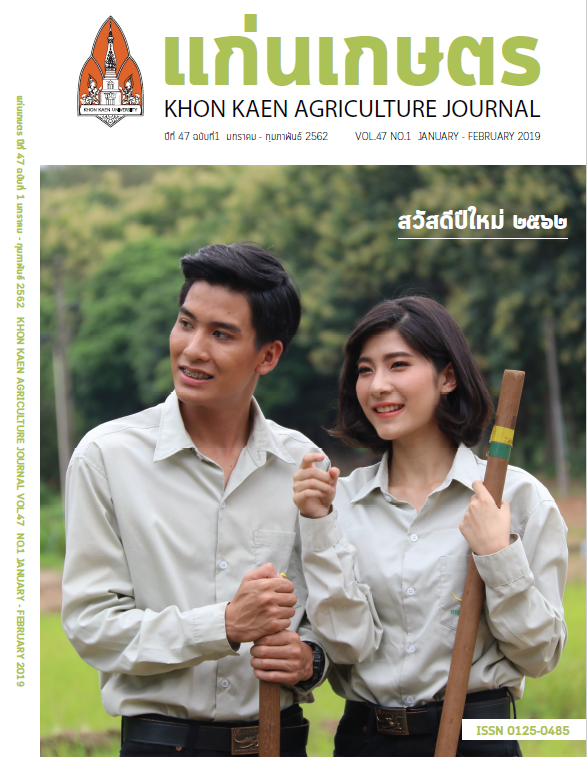ประสิทธิภาพของสารสกัดฟีนอลิกจากใบอ้อยในการกำจัดเห็บโค
Main Article Content
บทคัดย่อ
เห็บโคเป็นปรสิตภายนอกที่ก่อโรคและทำอันตรายต่อสุขภาพของโค งานวิจัยนี้มีวัตถุประสงค์เพื่อศึกษาประสิทธิภาพของสารสกัดใบอ้อยต่อการกำจัดเห็บโค โดยทำการสกัดใบอ้อยด้วยอะซิโตนและเอธานอลและทดลองในรูปแบบสารสกัดหยาบที่ระดับความเข้มข้น 300, 600, และ 1,200 ไมโครกรัม/มิลลิลิตร บันทึกอัตราการตายใน 48 ชั่วโมง และดัชนีการขยายพันธุ์ภายใน 15 วัน พบว่า สารสกัดที่ความเข้มข้น 1,200 ไมโครกรัม/มิลลิลิตรมีประสิทธิภาพในการกำจัดเห็บโคดีที่สุดเมื่อเปรียบเทียบกับกลุ่มควบคุม และสารสกัดความเข้มข้นอื่นๆ (P<0.05) โดยมีอัตราการตายของเห็บเท่ากับ 75 เปอร์เซนต์ ค่าดัชนีการวางไข่และเปอร์เซนต์การยับยั้งการขยายพันธุ์เท่ากับ 0.12 และ 52 ตามลำดับ โดยที่กลุ่มควบคุมลบที่เติม Polyethylene glycol (PEG, สารยับยั้งการทำงานของฟีนอลิก) มีค่าเปอร์เซนต์การตายของเห็บโค เท่ากับ 0 และค่ามัธยฐานของความเข้มข้นที่เป็นพิษ (LethalConcentration 50 : LC50) ของสารสกัดใบอ้อยมีค่าเท่ากับ 1000 ไมโครกรัม/มิลลิลิตร ดังนั้นสารประกอบฟีนอลิกที่ได้จากสารสกัดใบอ้อยมีประสิทธิภาพในการกำจัดเห็บโค ซึ่งสามารถนำไปประยุกต์ใช้เพื่อการพัฒนาวิธีควบคุมและกำจัดเห็บโคโดยใช้สารจากธรรมชาติต่อไปในอนาคต
Article Details
เอกสารอ้างอิง
จำรัส ใจลังกา, ธีระ จันทร์แก้ว, และพลภักดี นิตย์น้อยสืบ. 2550. ผลการสกัดสารจากน้อยโหน่ง ตะไคร้หอม ยาสูบ และโล่ติ๊นในการกำจัดเห็บโค. วารสารสำนักงานปศุสัตว์จังหวัดพิษณุโลก. 12 : 1-11.
ฤทัยรัตน์ น้อยคนดี. 2551. สารสกัดใบแทนนินจากใบมันสำปะหลังเพื่อการบำบัดคุณภาพน้ำเสีย วิทยานิพนธ์ปริญญาวิทยาศาสตรมหาบัณฑิต มหาวิทยาลัยเกษตรศาสตร์ กรุงเทพมหานคร
มหิดล. 2529. ก้าวไปกับสมุนไพร. คณะเภสัชศาสตร์ มหาวิทยาลัยมหิดล. กรุงเทพมหานคร
Abbott, W.S., 1925. A method of computing the effectiveness of an insecticide. J. Econ. Entomol. 23: 265-267
Adam, E., D. Ahmed, and O. M. Amna. 2015. An assessment of mechanical and manual harvesting of sugarcane in Sudan – The case of Sennar Sugar Factory. J. Saudi Soc. Agri. Sci. 4: 160-166
Bowman, D.D., and L. Ott. 2009. Georgis Parasitology for Veterinarian. 9th edition. Suanders Elsevier Inc. Missouri, USA.
Bruneton, J., 1999. Pharmacognosie (Phytochimie, plantes medicinales). France.
Christiane, M., M. Barceelos, A. Maria, and A. Zacarias. 2011. Strategic control of cattle ticks : milk producers’ perceptions. Parasitol. Vet. 20: 148-154.
Chungsamarnyart, N., S. Jiwajinda, C. Rattanakreetakul, and W. Jansawan. 1992. Acaricidal effect of practical crude extract of plants against tropical cattle ticks. Kasetsart Journal : Natural Science, 27: 57-64
Ghosh, S., P. Azhahianambi, and MP. Yada. 2007. Upcoming and future strategies of tick control : A Review. J Vect Borne Dis. 442: 79-89
Greeshma, U.B., B. Narladkar, and S. Rajurkar. 2018. In- vitro evaluation of the herbal acaricide product against the cattle tick Rhipicephalus (B.) microplus (Acarina : Ixodidiae). J. Ent. Zool. Stud. 6: 544-548
Joseph, E., N. Felicia, and I. Njoku. 2014. Survey of Tick Infestation of Cattle at Four Selected Grazing site . Global Vet . 12: 479-486.
Kidd, L. and E.B. Breitschowerdt. 2003. Transmission times and prevention of tick borne disease in dogs. Compendium, 10: 742-51
Latif, A.,and A. Walker. 2004. Introduction to the Biology and Control of Ticks in Africa. ICTTD – Project. 1-29
Makkar, H.P. 2003. Quantification of tannins in tree and shrub foliage. : A Laboratory Manual Food and Agricuture organization of the United Nations. International Atomic Energy Agency (FAO/IAEA), Vienna, Austria. 49-53.
Marie, C., L. Udino, L. Philibert, B. Bocage, and H. Archimed. 2010. In vitro effects of Cassava leaf extracts on four development stages of Haemochus contortus. Vet Parasitol. 173 : 85-92.
Rajput, ZI., H.H. Song, JC. Wan, G.A. Abdullah, and X. Chen. 2006. Importance of ticks and their chemical and immunological control in livestock. J. of Zhejiang University Science. 11: 912-21
Seyoum, Z., 2001. Study of ticks and tick born disease on cattle at Girang Valley in North Wollozone proceeding of the Ethiopian. Veterinary association. 15
Slinkard, K., and V.L. Singleton. 1997. Total phenol analysis: automation and comparison with many method. American Journal of Enoogy and Viticuture. 28: 49-55
Shaw, S.E. ,2001. Tick borne infectious disease of dogs. Trends in Parasitology. 172 : 74-80
Tagesu, A. 2017. Review on Traditional Medicine Plant and its Extract Effect on Tick Control in Ethiopia , J. Vet Med. Res. 4 : 1082
Taylor, M.A., R.L. Coop, and R.L. Wall. 2007. Parasitiology. 3rd edition. Blackwell Publishing Ltd. UK.
Willaims, C., J.B. Harborn, and P. Smith. 1974. The taxonomic significance of leaf flavonoids in Saccharum and related genera. Phytochemistry 13: 1141-1149.


